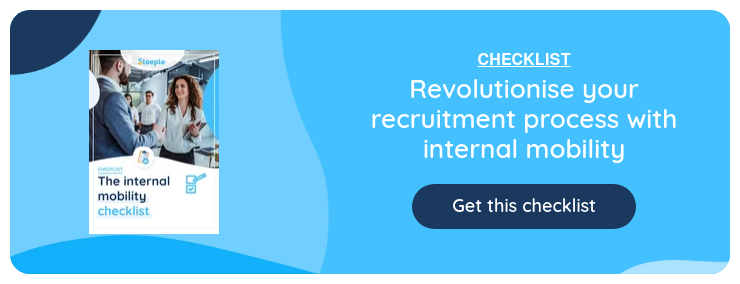Published on 16/05/2024
We are hearing more and more about internal mobility within companies. It responds to a demand from employees who are questioning their role in the company and want to improve their employee experience.
Employees are looking for meaning in their work:
- No longer be locked into a job and working conditions that no longer suit them, even out of habit
- Take part in a genuine long-term corporate project
- Have an outlook over several years
This situation is a real headache for Human Resources (HR) and Managers, who are struggling to retain their staff in the face of ever-increasing staff turnover, accentuated by employees who do not feel stimulated.
At the same time, there is a real shortage of talent. Yet there is a practical solution to these problems: internal mobility within companies.
Find out in this article what internal mobility is and how to implement it in your company to reap all its benefits.
#1 - What is internal mobility?
Internal mobility definition
Internal mobility within a company is when an employee changes position or department within the company. The request for mobility may come directly from the employee (voluntary mobility) or be proposed by the manager and/or Human Resources.
Internal mobility can be implemented in both small and large companies. In SMEs and other small organisations, employees are naturally encouraged to be multi-skilled.
Internal career development can therefore be facilitated by employees' ability to adapt quickly and easily. In a large group or a fast-growing company, internal mobility is facilitated by the fact that the organisation is structured.
As new jobs are created, more and more opportunities will be offered to employees.
Different types of internal mobility
Professional mobility within companies can take different forms:
➡️ Vertical mobility
Vertical mobility means moving to a position with greater responsibility.
➡️ Horizontal mobility
Horizontal mobility involves changing jobs within the company. It often involves a complete change of core business. This is known as internal career transition.
➡️ Cross-disciplinary mobility
Cross-functional mobility means taking on more responsibilities while changing departments.
➡️ Geographical mobility
Geographical mobility offers employees the opportunity to change their workplace. This may be for an equivalent position or for a change of profession.
These different types of internal mobility therefore offer a wide range of possibilities for companies wishing to develop their employees.
The challenges of internal mobility
The challenges of internal mobility within companies are therefore considerable:
- By offering its employees career development opportunities, the company ensures that its teams are stimulated. They are challenged and feel valued. It's an excellent way of building employee loyalty.
- The costs associated with poor recruitment or the departure of an employee are considerable. They represent a significant loss for the company.
In the case of unsuccessful recruitment, there is a loss in a number of areas, such as
- employee remuneration
- departure expenses
- HR department remuneration
- recruitment software
- advertising costs
- infrastructure and equipment used
For example, setting up an internal mobility plan could be a sustainable solution for guiding a person who is not fulfilled in the position for which he or she was recruited. It would complement an appropriate internal communication plan.
#2 - How can we encourage internal mobility?
Create an internal mobility process
To set up an effective internal mobility process within a company, a few rules need to be observed.
First of all, it is important to structure the company's mobility plan. It will serve as a guide for setting up internal mobility and will help to avoid any drifts.
It should cover:
- the application process
- the conditions for eligibility and selection criteria
- the framework for implementing the mobility, which explains the more or less rapid transition between the two positions
- any assistance for changing jobs
To ensure that this is as accurate as possible, you will need to draw up a career plan specific to the company to which you can refer.
Communicating opportunities
To be effective, it is essential to communicate transparently about internal mobility or cooptation opportunities. As soon as a position is open for recruitment, it will be necessary to share it first internally to optimize the chances of mobility before circulating it externally.
Company internal mobility tools
To communicate effectively about available offers and process requests quickly, an internal mobility management tool will be of great use.
Ideally, you should have a comprehensive tool for managing the process. To do this, you need to be able to manage the distribution of available positions, the submission of applications and follow-up.
Offering training / support from HR and your manager
To support internal mobility within the company and convince reluctant employees, it may be worth offering training courses linked to the proposed changes.
The Human Resources (HR) department will have a key role to play in this. The manager, as for him, should offer to supervise and train the newcomer in his team, so that he can develop his skills quickly and concretely.
#3 - Why promote internal mobility?
Benefits for the employee
The first advantage of internal mobility is that it allows employees to develop their skills. Staff often feel trapped in a precise mission. They feel that their employer does not make the effort to set up training plans to help them develop their skills.
The employee career path plays an important role in the feeling of well-being at work. Internal mobility should be seen as a professional opportunity, a way to breathe new life into one's career without having to change company.
With the prospect of career development within the same organization, employees can live their experience as employees with peace of mind, looking ahead to the years to come.
Benefits for the company
Internal mobility is a real performance driver for companies.
➡️ First benefit: improve employee loyalty
The first benefit to be noted in terms of concrete impact is employee loyalty.
Employees are increasingly volatile. As a result, it is more complicated for companies to retain their talent.
Staff turnover can rapidly increase. This is a major threat, because these changes in the workforce reflect badly on both employees and potential future candidates.
A company with high staff turnover is a company that is not doing enough to retain its employees.
Internal mobility is a real demonstration of the company's confidence in its employees. Those who benefit from internal mobility will be grateful for this opportunity and consequently committed to their new mission.
If it is proven through a range of actions that the company aims to improve the employee experience, then employee loyalty will be all the stronger and it will be possible to reduce staff turnover.
➡️ Second benefit: encourage employee commitment
At work, employees need to have a sense of belonging. The company's success depends on employee commitment: it depends on the impact of the employer brand.
By sharing a detailed career plan with employees, with opportunities for development linked to internal mobility, the desire to participate in this project will be stronger. By feeling supported and fulfilled, staff will be the company's first ambassadors via the employee advocacy strategy.
➡️ Third benefit: turn your employees into multidisciplinary experts
In the case of SMEs and very small businesses, internal mobility has another significant advantage for the company. It naturally leads employees to become multi-skilled.
Progressively they will, in fact, gain knowledge and skills that they will be able to put to good use for the company. This multidisciplinarity will gradually enable employees to become experts thanks to their global view of the company.
➡️ Fourth benefit: reorganise the company and simplify recruitment
One of the challenges companies face is recruitment. Through internal mobility, internal recruitment can be implemented.
This makes the recruitment process much easier. The costs and time involved are reduced for the company:
- The offer is posted quickly and easily on a dedicated internal mobility tool.
- Applications are processed more efficiently because the profiles are known to the Human Resources (HR) team.
Similarly, if the company decides to restructure its organization, this will be facilitated by the possibility of developing existing profiles directly. Finally, by recruiting internally, you avoid unpleasant surprises and have a faster onboarding period.
➡️ Benefit 5: reduced recruitment costs
Human Resources know that the recruitment process is expensive. It requires resources for searching for profiles, using tools to circulate offers or accessing a database of resumes.
Time will then have to be spent on the administrative formalities to validate the recruitment and prepare for onboarding.
Unsuccessful recruitment will therefore cost the company money. These expenses will have to be repeated to find new candidates and hope that they go beyond their trial period.
Implementing an internal mobility policy will therefore massively reduce recruitment costs.
#4 - How does one apply for internal mobility?
When applying for internal mobility, the process should be as simple as possible for the employee, so as not to make the process discouraging.
The ideal solution is to set up an internal mobility tool within the company.
Steeple's Jobs application
At Steeple, we offer the Jobs application, which is available directly on our platform in the form of a subscription per month and per employee: you centralise all your internal communication with your employees, even for internal recruitment.

This way, your employees won't be put off by using yet another piece of software that they rarely consult.
The Jobs application can be used to distribute job offers eligible for co-option or internal mobility to all employees.
The Steeple Jobs application: how does it work ?
At the click of a button, employees can browse internal open roles, apply for jobs, coopt others and track their progress. This could revolutionize recruitment in:
- Reducing recruitment times
- Involving employees
The added bonus of the Steeple Jobs App: the advertisements are visible directly on the home screen of our internal communication tool, so they're visible at a glance.
Gone are the days when you had to wait for your annual interview to discuss your career development ambitions, thanks to our internal mobility and co-option application.
#5 - The internal mobility in a nutshell
Internal mobility is a real opportunity for companies. It is a means of motivating and involving employees.
It can be implemented in small structures as well as large groups, and in a variety of ways.
It offers numerous advantages for both employees and companies. The main advantages of internal mobility within a company include:
- Development within the company
- Tenfold motivation
- An easier recruitment process
To be effective and quick to implement, it should be managed via a dedicated internal mobility application.
Would you like us to help you implement your internal mobility policy or find out more about our Jobs App ?
Foire aux questions (FAQ)
The employee experience represents the employee's life cycle within the company. It begins at the recruitment stage and ends when the employee leaves the company (offboarding).
The employee experience must be mastered from start to finish to guarantee a stimulating working day for the talent.
Visit our dedicated page What is the employee experience?
Within a company, cooptation is when an employee recommends one of his or her contacts for open recruitment.
It has a number of advantages:
- Employees who recommend someone they know make a commitment to the company. We can therefore be sure that they will propose a reliable and competent profile for the post on offer.
- It reduces recruitment time. The advertisement does not need to be posted on various platforms, and Human Resources do not have to spend hours searching through CV libraries.
- Finally, by reducing working hours, the company makes financial savings at the same time.
There are many advantages to using an internal recruitment application:
- facilitating internal mobility requests
- easily share available vacancies
- communicate available vacancies to all employees
Discover the Jobs internal mobility application
About the author
Steeple Team
Chargée de contenus
Read all the articles from the Steeple team, the experts in internal communication and employee experience.
-1.png)











